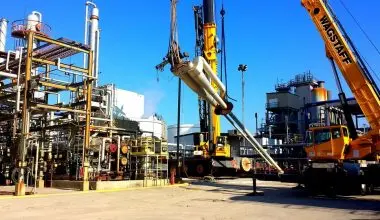Table of Contents Show
With the increasing demand of energy, we have been forced to find new alternatives to meet the requirements and although renewables seem to be the talk of town but in reality it is still far from fulfilling the demands of the huge world’s population.
Therefore, till the time comes when we switch to renewables for good we have to use conventional fossils. However, with rapidly growing data about the dangers these fuels pose to our environment, people are developing newer methods to avoid these effects. One such method is hydraulic fracturing or fracking, which is being used since the 1940s.
What is Fracking?
Fracking is basically a process in which we extract hydrocarbons like natural gas and oil from rocks, like sandstone and shale, which have low permeability and porosity. Horizontal drilling is done several kilometers beneath the ground high volumes of water, along with other chemicals including sand are pumped at very high pressures. These conditions fracture the rocks and release the gas which is collected via wells.
This process is relatively cheaper as compared to other conventional methods of extracting from shale and is deemed to be more environment friendly by multiple studies in the early 2000s. In 2004, even EPA labeled it as a safe process with no harmful effects on drinking water.
This was concealed information for years!
Since the start of fracking there had been a catch; the companies would not disclose the substances being used in the process because of it being classified as ‘propriety information’. With the change in disclosure laws in 2012, the tables are turning, and recent research is pointing to the fact that although the process of fracking itself might be cleaner than conventional methods, but the chemicals used to induce fractures in rocks are very dangerous to humans.
There is a real evidence emerging of those chemicals seeping from the ground into any nearby drinking water source and agricultural land, leading to contamination of groundwater. US House of Representatives Committee on Energy and Commerce Minority Staff found more than 650 carcinogens or possible carcinogens being used in fracking. This doesn’t account the secondary substances that are released in the flowback liquid and gas and waste products which include heavy metals like arsenic and selenium and radioactive substances.
So lets dive right into it!
What are the most harmful chemicals used in Fracking?
Let me List them out first; then we’ll get into the specifics of each.
- Methane
- Benzene
- Hydrogen Sulfide
- Formaldehyde
- Diesel Fuel
- Lead
- Hydrogen Fluoride and Naphtene
- Sulfuric Acid
- Silica
Let’s start with Methane!
1. Methane
Fracking aims to produce natural gas i.e. methane as the final product with oil as a secondary product. Methane has been proven to be safest among the list of commonly used fossil fuels, but that does not mean it is a godsend fuel. Methane is a very dangerous greenhouse gas and is already reported to be found in much more figures in air than deemed safe. The problem with fracking is that it makes itself seem like a great prospect on the surface, but its underlying realities have far etching effects.
According to new research, methane leaks in the environment from the start of fracking to its reaching consumer is around 4% but on the other hand the total emissions from conventional methods, which have very less leaking possibility, is less than 1%. This is a substantial figure because methane is not only damaging environment but can also be fatal to us.
2. Benzene
The most common toxic substance found near the sites of fracking has been benzene which in one particular site was almost five times the allowed limit. Benzene has long been positively linked to bone marrow dysfunction and blood cancers or leukemias. Not only that even the derivates of benzene like toluene, and ethylbenzene have also been found to have detrimental effects on the human nervous system.
3. Hydrogen Sulfide
Hydrogen sulfide, which can rapidly induce its toxic effects like eye irritation and dizziness in just over an hour of exposure was found in enormous amounts of 90 to 60000 times more than the normal limit. Excluding these acute symptoms with long exposure hydrogen sulfide can easily effect lungs and brain.
4. Formaldehyde
Another carcinogen found in pronounced levels of 30 to 240 times is formaldehyde. Formaldehyde is used as a preservative and is so toxic that drinking even a small amount of it by mistake can directly lead to death. But mouth isn’t the only source of getting it in our body, as even with long exposure of air containing formaldehyde can lead to respiratory damage.
5. Diesel fuel
Diesel fuel has already been labelled as hazardous in the clean air act and safe drinking water act, was also cautioned against in 2004 but no measures were taken to reduce its use in fracking. Diesel fuel can instantly damage skin on single contact and lead to cancer. Sometimes along with diesel kerosene is also used, whose vapors lead to brain damage and death with long term exposure.
6. Lead
Similar to diesel fuel is another toxic substance, lead, which has also been given the same label as diesel fuels in clean air act and safe drinking water act, is also used by some fracking companies. Lead was once extensively used in fuels and paints but after its neurological symptoms were proven in 20th century has been phased out from wherever possible, unfortunately fracking has not entirely been independent of it. Lead exposure can lead to brain damage and blood disorders, with the symptoms being more prominent in children.
7. Hydrogen Fluoride and Naphthene
Some of the other substances from the list of hazardous substances in clean air act are hydrogen fluoride and naphthene. Hydrogen fluoride is a highly corrosive substance whose fumes can lead to severe burns on contact and inhalation can severely damage bones. At the end it is considered fatal, irrespective of the route.
Along with Hydrogen Fluoride, Naphthene is a common household item that can damage respiratory system as well as digestive system of human body.
8. Sulfuric Acid
One of the most dangerous acids used in fracking is sulfuric acid, which is commonly used in batteries, can damage any part of body it comes into contact with. A small dose is enough to cause death.
9. Silica
Along with water and sand, Silica is considered an essential part of fracking fluid that is pumped. Silica with long term exposure leads to cancers and silicosis. The irony here is that fracturing the rocks beneath ground like shale, release dust or silica which means in simpler words we pump a carcinogen to release the same carcinogen from the ground.
Conclusion
This is just the start and can’t even be called tip of the iceberg because our trade secret laws have made it possible for fracking companies to bury the iceberg as much as possible. With the recent changes in laws and pressure from environmentalists, we are able to slightly grasp the damage that has been going on for several decades, but our efforts have not been enough to slow down the race for fossil fuels. An alarm has been set and it is a good thing that research is catching pace but till that time companies do need to deploy some safety measures.






1 comment
Your mode of explaining all in this post is truly pleasant, all
can simply be aware of it, Thanks a lot.